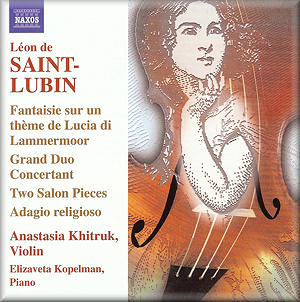 |
 |
|


alternatively
CD: AmazonUK
AmazonUS
Download: Classicsonline
|
Léon de
SAINT-LUBIN (1805-1850)
Virtuoso works for Violin - Volume 1
Grand Duo Concertant, Op. 49 (published 1847) [27:45]
Fantaisie sur un thème de Lucia di Lammermoor, Op. 46 (published
1844) 6:28]
Thème Original et Etude de S. Thalberg, Op. 45a (published
c.1843) [6:03]
Adagio Religioso, Op. 44 published 1842 [6:43]
Potpourri on themes from Auber's La Fiancée, Op. 35 [13:38]
Salonstucke, Op. 47: No. 1. Nocturne [3:02] and Rondino [3:45]
Salonstucke, Op. 47, No. 2: Nocturne [2:26] and Polonaise [4:57]
 Anastasia Khitruk (violin)
Anastasia Khitruk (violin)
Elizaveta Kopelman (piano)
rec. Glenn Gould Studio, CBC, Toronto, June 2008
 NAXOS 8.572019 [75:16]
NAXOS 8.572019 [75:16]  |
|
|
Naxos continues its exploration of the byways of the violinistically
arcane with this disc devoted to Saint-Lubin. Rather like Rode,
his is a name more honoured in the breach than in concert performance
these days. Saint-Lubin was born in Turin in 1805 to a French
family that had fled the Revolution (he was actually christened
Napoléon-Antoine-Eugène). At the age of about
four the family moved to Hamburg and subsequently he studied
with Spohr, and then gravitated to Vienna. Here he met Beethoven,
who wrote a small cadenza for him to play in 1822. Having then
heard Paganini he withdrew to an estate in Hungary, that of
an aristocratic patron, to work on his technique, but by 1830
he was back in the public eye as concertmaster of the Royal
Municipal Theatre in Berlin, where he died at an early age in
1850.
The major work in this first volume is the Grand Duo Concertant,
published in 1847. It's a curious hybrid, with the piano
writing often sounding decidedly Beethovenian whilst the violin
spins a lyric line that sounds part derived from Schubert. It's
very well written for both instruments and extremely well paced.
There's grace and also a touch of drollery, maybe even frivolity
in the opening movement, whilst the second has a strong Beethovenian
cast to it, and is full of verve. There's a warm slow movement,
nothing too fulsome to over balance the schema, which sports
a perky and extrovert B section. A bright, keen Allegretto finishes
the work in style.
The other works fall into well established genres of writing
- the operatic variations, the salon charmers, and the mildly
lachrymose sweetmeat. The Fantaisie sur un thème de
Lucia di Lammermoor obviously falls into the first category,
a display piece of considerable virtuosity, calling for a battery
of resources and majoring on left hand pizzicato and tremolandi
to fan the flames; clearly a post-Paganinian confection, which
Anastasia Khitruk digs into with chewy vibrato and great panache.
The Potpourri on themes from Auber's La Fiancée is
another paraphrase, just as demanding, but also exuding veritable
whiffs of stage paint. The Thème Original et Etude
de S. Thalberg, Op. 45a is cleverly wrought - an arrangement
for violin of a piano etude it transfers to the new medium extremely
convincingly, even exuding as it does considerable bowing difficulties.
It was dedicated jointly to Bazzini and Sivori so Saint-Lubin
was reaching out to the best. As one would expect the Adagio
Religioso is warmly textured but fortunately not too religiose.
And the salon morceaux that end the disc are full of lightweight
charm and rather generic dance patterns.
With fine recorded sound and notes this first volume gets off
to a cracking start. Khitruk and Elizaveta Kopelman are first
class ambassadors for this kind of music and marry virtuosity
with elegance throughout.
Jonathan Woolf
|
|

